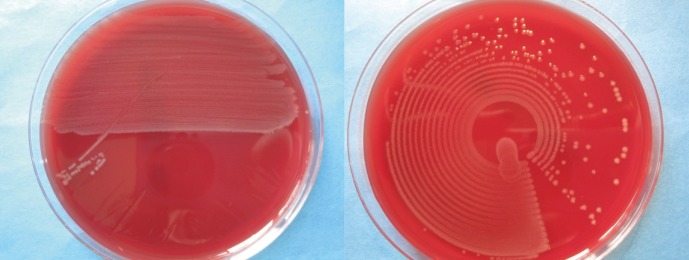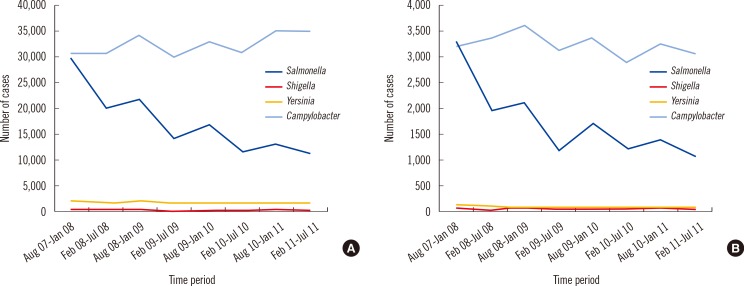Ann Lab Med.
2015 Jan;35(1):82-88. 10.3343/alm.2015.35.1.82.
Evaluation of the Impact of Automated Specimen Inoculation, Using Previ Isola, on the Quality of and Technical Time for Stool Cultures
- Affiliations
-
- 1Department of Infectious Diseases, Medical Microbiology and Hygiene, Heidelberg University Hospital, Heidelberg, Germany. stefan.zimmermann@med.uni-heidelberg.de
- KMID: 2363152
- DOI: http://doi.org/10.3343/alm.2015.35.1.82
Abstract
- BACKGROUND
This study was designed as a quasi-experiment to evaluate automatic inoculation of fecal specimens, using the automated specimen inoculator Previ Isola (bioMerieux, France).
METHODS
We evaluated the quality of cultures, recovery rates of enteropathogenic bacteria (Salmonella, Shigella, Campylobacter, and Yersinia species), and cost-effectiveness in terms of technical time. The Previ Isola recovery rates for the two-year period from August 2009 to July 2011 were compared with historical manual inoculation data of the previous two years (August 2007 to July 2009). The regional (Baden-Wurttemberg) and nationwide (Germany) trends of recovery rates for this four-year period were referred.
RESULTS
A total of 5,884 fecal specimens were collected over the study period. Most positive cultures were for Salmonella, followed by Campylobacter. Compared with the historical data, the numbers of Campylobacter-positive specimens for a year between August and July were increased significantly, from 19 in 2007-2008 and 10 in 2008-2009 to 32 in 2009-2010 (P=0.002) and 32 in 2010-2011 (P=0.003), respectively. During the study period, the official data for our region and nationwide did not show this increase in the recovery rate of Campylobacter. For Salmonella, Shigella, and Yersinia, no significant changes were observed. Compared with manual inoculation, the mean hands-on time with Previ Isola inoculation was significantly shortened, from 37:30 min to 8:42 min per 15 fecal specimens.
CONCLUSIONS
Inoculation by Previ Isola improves the quality of routine culture of fecal specimens, with better sensitivity for Campylobacter and less hands-on time.
Keyword
MeSH Terms
Figure
Reference
-
1. Glasson JH, Guthrie LH, Nielsen DJ, Bethell FA. Evaluation of an automated instrument for inoculating and spreading samples onto agar plates. J Clin Microbiol. 2008; 46:1281–1284. PMID: 18272700.
Article2. Weinstein MP, Murphy JR, Reller LB, Lichtenstein KA. The clinical significance of positive blood cultures: a comprehensive analysis of 500 episodes of bacteremia and fungemia in adults. II. Clinical observations, with special reference to factors influencing prognosis. Rev Infect Dis. 1983; 5:54–70. PMID: 6828812.
Article3. Bourbeau PP, Ledeboer NA. Automation in clinical microbiology. J Clin Microbiol. 2013; 51:1658–1665. PMID: 23515547.
Article4. Bourbeau PP, Swartz BL. First evaluation of the WASP, a new automated microbiology plating instrument. J Clin Microbiol. 2009; 47:1101–1106. PMID: 19158259.
Article5. Mutters NT, Hodiamont CJ, de Jong MD, Overmeijer HP, van den Boogaard M, Visser CE. Performance of Kiestra total laboratory automation combined with MS in clinical microbiology practice. Ann Lab Med. 2014; 34:111–117. PMID: 24624346.
Article6. Mischnik A, Mieth M, Busch CJ, Hofer S, Zimmermann S. First evaluation of automated specimen inoculation for wound swab samples by use of the Previ Isola system compared to manual inoculation in a routine laboratory: finding a cost-effective and accurate approach. J Clin Microbiol. 2012; 50:2732–2736. PMID: 22692745.
Article7. King GW, Kath GS, Siciliano S, Simpson N, Masurekar P, Sigmund J, et al. Automated agar plate streaker: a linear plater on Society for Biomolecular Sciences standard plates. J Biomol Screen. 2006; 11:704–711. PMID: 16844965.
Article8. Van Horn KG, Audette CD, Tucker KA, Sebeck D. Comparison of 3 swab transport systems for direct release and recovery of aerobic and anaerobic bacteria. Diagn Microbiol Infect Dis. 2008; 62:471–473. PMID: 18814991.
Article9. Kist M, Bockemühl J, Aleksic S, Altwegg M, Autenrieth IB, Bär W, et al. Infektionen des Darms. In : Mauch H, Lütticken R, editors. Qualitätsstandards in der mikrobiologisch-infektiologischen Diagnostik. München, Jena: Urban & Fischer;2000. p. 32–39.10. Tilton RC, Ryan RW. Evaluation of an automated agar plate streaker. J Clin Microbiol. 1978; 7:298–304. PMID: 348722.
Article11. Nebbad-Lechani B, Emirian A, Maillebuau F, Mahjoub N, Fihman V, Legrand P, et al. New procedure to reduce the time and cost of broncho-pulmonary specimen management using the Previ Isola® automated inoculation system. J Microbiol Methods. 2013; 95:384–388. PMID: 24184016.
Article12. Tan KE, Ellis BC, Lee R, Stamper PD, Zhang SX, Carroll KC. Prospective evaluation of a matrix-assisted laser desorption ionization-time of flight mass spectrometry system in a hospital clinical microbiology laboratory for identification of bacteria and yeasts: a bench-by-bench study for assessing the impact on time to identification and cost-effectiveness. J Clin Microbiol. 2012; 50:3301–3308. PMID: 22855510.
Article13. Fitzenberger J, Uphoff H, Gawrich S, Hauri AM. Urban-rural differences of age- and species-specific campylobacteriosis incidence, Hesse, Germany, July 2005-June 2006. Euro Surveill. 2010; 15:pii: 19693.
Article14. Robert-Koch-Institut. Epidemiologie der Kryptokokkose in Deutschland von 2004 bis 2010. Epid Bull. 2012; 29:275. http://www.rki.de/DE/Content/Infekt/EpidBull/Archiv/2012/Ausgaben/29_12.pdf?__blob=publicationFile.15. European Centre for Disease Prevention and Control (ECDC). Annual epidemiological report. Reporting on 2011 surveillance data and 2012 epidemic intelligence data. Stockholm: ECDC;2013.16. Marcus R, Rabatsky-Ehr T, Mohle-Boetani JC, Farley M, Medus C, Shiferaw B, et al. Dramatic decrease in the incidence of Salmonella serotype Enteritidis infections in 5 FoodNet sites: 1996-1999. Clin Infect Dis. 2004; 38(S3):S135–S141. PMID: 15095182.17. Funke G, Kunert T, Barth B, Fulchiron C, Bossy G. New automated solution for plate streaking: comparative evaluation of the PREVI Isola in a microbiology lab. 19th European Congress of Clinical Microbiology and Infectious Diseases. Abstract number, P887. Helsinki: 2009. Updated on May 2009. http://www.lbtinnovations.com/assets/Uploads/eccmid092l.pdf.
- Full Text Links
- Actions
-
Cited
- CITED
-
- Close
- Share
- Similar articles
-
- Erratum: Evaluation of the Impact of Automated Specimen Inoculation, Using Previ Isola, on the Quality of and Technical Time for Stool Cultures
- Evaluation of Automated Specimen Inoculation for Blood Culture Samples by Use of the Previ Isola(R) System Compared with the Manual Method
- Evaluation of an Automated Instrument, PREVI Isola(R) for Inoculation of Body Fluids and Urine Samples onto Agar Plates
- A Technical Note on a Novel Technique for the Evaluation of Breast Excision Specimen: Automated Breast Ultrasound System
- Analyzing Patterns for Stool Culture Requests by Physicians to Improve Quality



